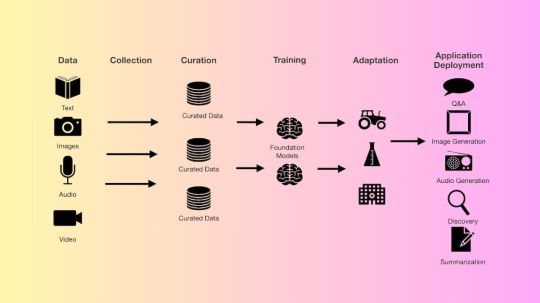#generativeaisolutions
Explore tagged Tumblr posts
Text
GenOps: MLOps’ Advancement For Generative AI Solutions

Organizations frequently encounter operational difficulties when they attempt to use generative AI solutions at scale. GenOps, also known as MLOps for Gen AI, tackles these issues.
DevOps principles and machine learning procedures are combined with GenOps to deploy, track, and manage Gen AI models in production. It guarantees that Gen AI systems are dependable, scalable, and ever-improving.
Why does MLOps pose a challenge to Gen AI?
The distinct issues posed by Gen AI models render the conventional MLOps approaches inadequate.
Scale: Specialized infrastructure is needed to handle billions of parameters.
Compute: Training and inference require a lot of resources.
Safety: Strong protections against hazardous content are required.
Quick evolution: Regular updates to stay up to speed with new discoveries.
Unpredictability: Testing and validation are made more difficult by non-deterministic results.
We’ll look at ways to expand and modify MLOps concepts to satisfy the particular needs of Gen AI in this blog.
Important functions of GenOps
The many components of GenOps for trained and optimized models are listed below:
Gen AI exploration and prototyping: Use open-weight models like Gemma2, PaliGemma, and enterprise models like Gemini and Imagen to experiment and create prototypes.
Prompt: The following are the different actions that require prompts:
Prompt engineering: Create and improve prompts to enable GenAI models to produce the intended results.
Versioning prompts: Over time, manage, monitor, and regulate changes to prompts.
Enhance the prompt: Use LLMs to create a better prompt that optimizes output for a particular job.
Evaluation: Use metrics or feedback to assess the GenAI model’s responses for particular tasks.
Optimization: To make models more effective for deployment, use optimization techniques like quantization and distillation.
Safety: Install filters and guardrails. Safety filters are included into models like Gemini to stop the model from responding negatively.
Fine-tuning: Apply further tuning on specialized datasets to pre-trained models in order to adapt them to certain domains/tasks.
Version control: Handle several iterations of the datasets, prompts, and GenAI models.
Deployment: Provide integrated, scalable, and containerized GenAI models.
Monitoring: Keep an eye on the real-time performance of the model, the output quality, latency, and resource utilization.
Security and governance: Defend models and data from intrusions and attacks, and make sure rules are followed.
After seeing the essential elements of GenOps, let’s see how the traditional MLOps pipeline in VertexAI may be expanded to include GenOps. The process of deploying an ML model is automated via this MLOps pipeline, which combines continuous integration, continuous deployment, and continuous training (CI/CD/CT).
https://googleads.g.doubleclick.net/pagead/ads?client=ca-pub-2426501425899553&output=html&h=280&slotname=4563146714&adk=546512204&adf=318346453&pi=t.ma~as.4563146714&w=696&abgtt=7&fwrn=4&fwrnh=100&lmt=1726902097&rafmt=1&format=696x280&url=https%3A%2F%2Fgovindhtech.com%2Fgenops-mlops-advancement-for-generative-ai%2F&host=ca-host-pub-2644536267352236&fwr=0&fwrattr=true&rpe=1&resp_fmts=3&wgl=1&uach=WyJXaW5kb3dzIiwiMTAuMC4wIiwieDg2IiwiIiwiMTI5LjAuNjY2OC41OCIsbnVsbCwwLG51bGwsIjY0IixbWyJHb29nbGUgQ2hyb21lIiwiMTI5LjAuNjY2OC41OCJdLFsiTm90PUE_QnJhbmQiLCI4LjAuMC4wIl0sWyJDaHJvbWl1bSIsIjEyOS4wLjY2NjguNTgiXV0sMF0.&dt=1726901827507&bpp=5&bdt=392&idt=233&shv=r20240912&mjsv=m202409120101&ptt=9&saldr=aa&abxe=1&cookie=ID%3D2f07fe693acedb0c-22cd63e9a9e4003d%3AT%3D1698317162%3ART%3D1726898455%3AS%3DALNI_MZVYMuvf4fPSHFS0Ka8b16tqpqsCw&gpic=UID%3D00000c7492103e27%3AT%3D1698317162%3ART%3D1726898455%3AS%3DALNI_MZdViGyI9M8lNgUewCtxNjuvm6ACQ&eo_id_str=ID%3D370163078a0675ed%3AT%3D1725950955%3ART%3D1726898455%3AS%3DAA-AfjYsmyhNReuihzZG0PaW85Ki&prev_fmts=0x0&nras=1&correlator=2491702770370&frm=20&pv=1&u_tz=330&u_his=5&u_h=768&u_w=1366&u_ah=728&u_aw=1366&u_cd=24&u_sd=1.1&dmc=8&adx=79&ady=3390&biw=1226&bih=583&scr_x=0&scr_y=1069&eid=44759875%2C44759926%2C44759837%2C44795921%2C95342765%2C95342338%2C95340253%2C95340255&oid=2&pvsid=4267558874159984&tmod=799609756&uas=1&nvt=1&ref=https%3A%2F%2Fgovindhtech.com%2Fwp-admin%2Fedit.php%3Fpost_status%3Dpublish%26post_type%3Dpost&fc=1920&brdim=0%2C0%2C0%2C0%2C1366%2C0%2C1366%2C728%2C1242%2C583&vis=1&rsz=%7C%7CoEebr%7C&abl=CS&pfx=0&fu=128&bc=31&bz=1.1&td=1&tdf=2&psd=W251bGwsbnVsbCxudWxsLDNd&nt=1&ifi=2&uci=a!2&btvi=1&fsb=1&dtd=MGoogle Cloud
Continue MLOps to assist with GenOps
Let’s now examine the essential elements of a strong GenOps pipeline on Google Cloud, from the first testing of potent models across several modalities to the crucial factors of deployment, safety, and fine-tuning.Sample architecture for GenOps
Let’s investigate how these essential GenOps building blocks can be implemented in Google Cloud.
Data: The route towards Generative AI begins with data
Examples of few shots: Model output structure, phrasing, scope, and pattern are guided by the examples provided by few-shot prompts.
Supervised fine-tuning dataset: A pre-trained model is adjusted to a particular task or domain using this labeled dataset.
The golden evaluation dataset is used to evaluate how well a model performs in a certain activity. For that particular objective, this labeled dataset can be used for both metric-based and manual evaluation.
Prompt management: Vertex AI Studio facilitates the cooperative development, testing, and improvement of prompts. Within shared projects, teams can enter text, choose models, change parameters, and save completed prompts.
Model fine-tuning: Using the fine-tuning data, this stage entails adapting the Gen AI model that has already been trained to certain tasks or domains. The two Vertex AI techniques for fine-tuning models on Google Cloud are listed below:
When labeled data is available and the job is well-defined, supervised fine-tuning is a viable choice. It works especially well for domain-specific applications where the content or language is very different from the huge model’s original training set.
Strengthening Human feedback is used in learning from human feedback (RLHF) to fine-tune a model. In situations where the model’s output is intricate and challenging to explain, RLHF is advised. It is advised to use supervised fine-tuning if defining the model’s output isn’t challenging.
Visualization tools such as TensorBoard and embedding projector can be used to identify irrelevant questions. These prompts can then be utilized to prepare answers for RLHF and RLAIF.
UI can also be developed utilizing open source programs like Google Mesop, which facilitates the evaluation and updating of LLM replies by human assessors.
Model evaluation: GenAI models with explainable metrics are assessed using Vertex AI’s GenAI Evaluation Service. It offers two main categories of metrics:
Model-based measures: A Google-exclusive model serves as the judge in these metrics. Pairwise or pointwise measurements of model-based metrics are made with it.
Metrics based on computation: These metrics (like ROUGE and BLEU) compare the model’s output to a reference or ground truth by using mathematical formulas.
A paired model-based evaluation method called Automatic Side-by-Side (AutoSxS) is used to assess how well pre-generated forecasts or GenAI models in the VertexAI Model Registry perform. To determine which model responds to a prompt the best, it employs an autorater.
Model implementation:
Models that do not require deployment and have controlled APIs: Gemini, one of Google’s core Gen AI models, has managed APIs and is capable of accepting commands without requiring deployment.
Models that must be implemented: Before they may take prompts, other Gen AI models need to be deployed to a VertexAI Endpoint. The model needs to be available in the VertexAI Model Registry in order to be deployed. There are two varieties of GenAI models in use:
Models that have been refined through the use of customized data to adjust a supported foundation model.
Models using GenAI without controlled APIs Numerous models in the VertexAI Model Garden, such as Gemma2, Mistral, and Nemo, can be accessed through the Open Notebook or Deploy button.
For further control, some models allow for deployment to Google Kubernetes Engine. Online serving frameworks, such as NVIDIA Triton Inference Server and vLLM, which are memory-efficient and high-throughput LLM inference engines, are used in GKE to serve a single GPU model.
Monitoring: Continuous monitoring examines important metrics, data patterns, and trends to evaluate the performance of the deployed models in real-world scenarios. Google Cloud services are monitored through the use of cloud monitoring.
Organizations can better utilize the promise of Gen AI by implementing GenOps techniques, which help create systems that are effective and in line with business goals.
Read more on govindhtech.com
#GenOps#MLOps#GenerativeAISolutions#generativeAI#GenAI#RLHF#Gemma2#GeminiImagen#GenAImodels#VertexAI#GoogleCloud#GenAIEvaluationService#NVIDIATritonInference#nvidia#technology#technews#news#govindhtech
0 notes
Text
Generative AI Trends to Shape 2024 and Beyond

Generative Artificial Intelligence (AI) has been at the forefront of technological innovation, transforming various industries by enabling machines to create content autonomously. As we step into 2024, the landscape of generative AI is poised for unprecedented advancements. In this article, we will explore the emerging trends that are set to shape the future of generative AI and its impact on diverse sectors.
Generative AI has already demonstrated its ability to create stunning visual and written content, and in 2024, we can expect even more powerful creative applications. AI algorithms are becoming increasingly proficient at understanding human preferences and styles, enabling them to generate art, music, and literature that resonate with individuals on a deeply personal level.
Trends of Generative AI:
Advancements in Natural Language Processing (NLP):
Natural Language Processing has been a key area of focus in generative AI, and 2024 is expected to witness remarkable strides. The development of more sophisticated language models, capable of understanding context, sentiment, and even nuances in human language, will revolutionize communication between humans and machines. Improved language models will lead to enhanced conversational AI, making interactions with virtual assistants and chatbots more intuitive and personalized.
Multimodal AI:
The integration of multiple modalities, such as text, images, and audio, is a growing trend in generative AI. Multimodal AI models can process and generate content across different formats, enabling more comprehensive and realistic outputs. This is particularly evident in the field of creative arts, where AI-generated images, music, and even interactive storytelling are becoming increasingly sophisticated. In 2024, we can expect further breakthroughs in multimodal AI, resulting in more immersive and engaging user experiences.
AI-driven Creativity in the Arts:
Generative AI is making significant contributions to the creative arts, from painting and music composition to literature. Artists and creators are collaborating with AI systems to produce unique and innovative works. In 2024, we anticipate a surge in AI-driven creativity, with more artists embracing generative tools as partners in the creative process. This collaboration between human intuition and machine learning algorithms has the potential to redefine artistic boundaries and inspire entirely new forms of expression.
Ethical and Responsible:
As the capabilities of artificial intelligence expand, so does the importance of ethical considerations. Ensuring responsible and unbiased AI practices is a crucial trend that will gain prominence in 2024. Developers and organizations are increasingly recognizing the need for transparency, accountability, and fairness in AI systems. Stricter regulations and guidelines are likely to emerge, promoting ethical AI development and deployment across industries, from healthcare to finance.
AI for Personalized Healthcare:
Generative AI is making significant strides in the healthcare sector, with applications ranging from drug discovery to personalized treatment plans. In 2024, we can expect further advancements in AI-driven healthcare, particularly in the development of personalized diagnostics and treatment recommendations. Tailoring medical interventions to individual genetic profiles and health histories will become commonplace, improving patient outcomes and revolutionizing the healthcare.
Decentralized and Federated Learning:
As AI systems become increasingly integrated into our lives, the need for transparency and trustworthiness grows. Privacy concerns and the need for data-security are driving the adoption of decentralized and federated learning approaches in generative AI. These models allow training on distributed data sources without centralizing sensitive information. As the push for data privacy intensifies, 2024 is likely to witness a proliferation of decentralized and federated learning frameworks, enabling AI models to learn from diverse datasets without compromising individual privacy.
AI-enhanced Cybersecurity:
The increasing sophistication of cyber-threats necessitates innovative solutions, and generative AI is poised to play a crucial role in cybersecurity. AI-powered systems can analyze vast amounts of data to detect anomalies and potential security breaches in real-time. We can anticipate the integration of generative AI in cybersecurity measures, providing organizations with robust defense mechanisms against evolving cyber-threats.
AI for Climate Change Solutions: Greening the Future
Addressing global challenges such as climate change requires innovative solutions, and generative AI is stepping up to the plate. In the coming years, AI models will be leveraged to analyze environmental data, optimize resource usage, and propose sustainable solutions. From precision agriculture to energy efficiency, generative AI is expected to contribute significantly to the development of eco-friendly technologies. It also plays a crucial role in building a more sustainable future.
Conclusion:
The year 2024 holds great promise for the continued evolution of artificial intelligence across various domains. From advancements in natural language processing and multimodal AI to the ethical considerations and personalized applications in healthcare, the landscape is evolving at a rapid pace. As these trends unfold, it is essential for developers, businesses, and policymakers to collaborate in ensuring the responsible and ethical development of generative AI technologies that contribute positively to society’s progress. The future of generative AI is all about technological innovation. It is also about leveraging its potential to address real-world challenges and enhance the human experience. Embracing these trends responsibly and ethically will be essential as we navigate the evolving frontier of generative AI.
0 notes
Text
Generative AI Solutions & Development Services | Wappnet.ai
Empower your projects with cutting-edge Generative AI Solutions. Explore our development services for innovative outcomes. Contact us now!

#GenerativeAISolutions#GenerativeAICompany#GenerativeAIDevelopmentServices#GenerativeAISolutionsDevelopment
0 notes
Text

#GenerativeAiTools#GenerativeAiDevelopmentServices#GenerativeAiDevelopmentCompany#GenerativeAiServices#GenerativeAiDevelopment#GenerativeAiSolutions#GenerativeAiCompanies
0 notes
Text
Generative AI Development Company
Crafting tomorrow's possibilities with Generative AI! bit.ly/3UTh5wu 🌐✨ As your go-to Generative AI Development Company, we innovate solutions that push the boundaries of creativity and technology. Join us!
Explore : https://www.blockchainappsdeveloper.com/generative-ai-development-company
#blockchainappsdeveloper#Ai#generativeai#generativeaisolutions#customgenerativeai#AIinMedia#EntertainmentExamples#AIInnovation#MediaRevolution#FutureTechShowcase#SmartEntertainment#AIRevolution#MediaTransformation#TechInnovation#DigitalMedia#Chatgpt#googlebard#adobe#technology#digitaltransformation#Sweden#germany#USA#china#southkorea#canada#UAE#Uk#japan
0 notes
Text
SolGuruz is a leading Generative AI development company that offers affordable Generative AI Consulting, Gen AI Development Services, and innovative Generative AI Solutions. To hire Generative AI developers, contact us today.
#GenAIDevelopment#GenAIDevelopmentcompany#SolGuruz#GenerativeAI#GenerativeAIDevelopmentcompany#GenerativeAIDevelopmentServices#GenerativeAISolutions#GenerativeAIConsulting
0 notes
Text
Unveiling Hidden Opportunities in Your Data
Scient enterprise ai specializes in providing cutting-edge data mining solutions to businesses across various industries. Our team of experienced data scientists and analysts are dedicated to helping clients unlock the full potential of their data, uncovering valuable insights that drive informed decision-making and strategic growth.
Contact Information:
Website URL: https://www.scient.com/
Email: [email protected]
Contact Number: +1 609 683 1066
Unlock the hidden potential within your data with InsightMine Solutions. Contact us today to learn more about how we can help your business thrive in the data-driven era.
#generativeaisolution#Sciententerpriseai#artificialgeneralintelligencecompany#aitoolforbusiness#metadatamanagementsolution#aiautomationplatform
0 notes
Text
Explore the forefront of innovation as we showcase the top 10 Generative AI companies shaping the future landscape in 2024. Discover how these pioneering firms are empowering industries with groundbreaking advancements in artificial intelligence.
#GenerativeAIDevelopmentServices#GenerativeAICompanies#UnderstandGenerativeAI#GenerativeAIDevelopment#GenerativeAISolutions
0 notes
Text
Strategic Insights: AI vs. Generative AI - Optimizing Business Processes Gain valuable strategic insights into optimizing business processes with AI and Generative AI. Learn how partnering with a top Generative AI Development Company can revolutionize workflow efficiency, innovation, and competitiveness for your organization. Explore the nuanced differences between AI vs Generative AI and how each contributes uniquely to enhancing operational effectiveness. With the right guidance and expertise, you'll unlock the full potential of these technologies, driving sustainable growth and staying ahead in today's dynamic business landscape.
#GenerativeAIDevelopmentServices#GenerativeAICompanies#UnderstandGenerativeAI#GenerativeAIDevelopment#GenerativeAISolutions
0 notes